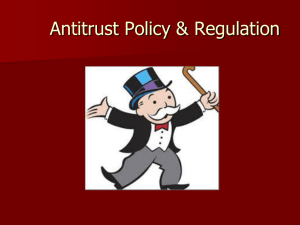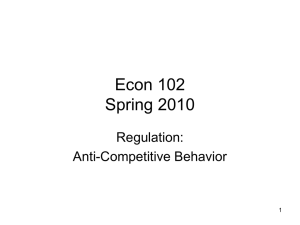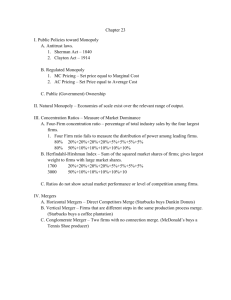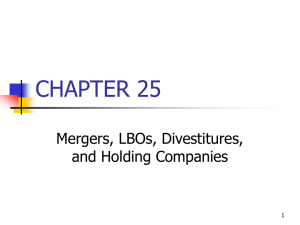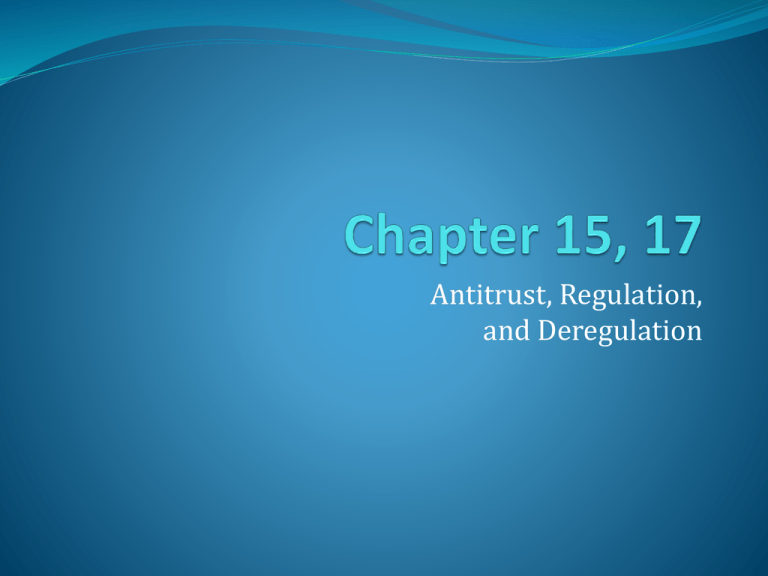
Antitrust, Regulation,
and Deregulation
The Government’s Role
in Promoting Efficiency
Studied the effects of the various market structures
and government policy (taxes, price controls) on
economy efficiency (deadweight loss).
Now: role of government in promoting economic
efficiency when there is market failure (the
unregulated market is inefficient).
Copyright © 2006 Pearson Addison-Wesley. All
rights reserved.
13-2
Why the Government Might
Intervene
Three main reasons why the government would
intervene in a market:
To promote productive efficiency
Resources are employed at the lowest cost.
To promote innovation
Creation and application of new technology
To promote allocative efficiency
Resources are distributed in the way that
society values most.
Copyright © 2006 Pearson Addison-Wesley. All
rights reserved.
13-3
Why the Government
Might Intervene (cont’d)
Most economists agree that the best way to achieve
efficiency and promote innovation is through
competition.
However, competitive markets do not always arise
naturally, and may even be undesirable in some
cases. (market failure)
Too few competitors / barriers to entry
Externalities (costs/benefits not price in market)
Assymetric information
Copyright © 2006 Pearson Addison-Wesley. All
rights reserved.
13-4
Natural and Optimal Market Structures
The natural structure of a market is the degree of
competition that would occur in the absence of
government intervention.
The optimal structure of a market is the degree of
competition that maximizes allocative efficiency.
Copyright © 2006 Pearson Addison-Wesley. All
rights reserved.
13-5
Natural and Optimal
Market Structures (cont’d)
The government will tend to intervene if the
natural structure differs significantly from the
optimal structure.
Copyright © 2006 Pearson Addison-Wesley. All
rights reserved.
13-6
The Sherman Antitrust Act of 1890
The basis of much of U.S. antitrust policy, the Sherman
Act outlaws:
Monopolies or attempts to monopolize
an industry
Standard Oil: Predatory Pricing
Dropping price < ATC to drive out competitors
McGee: found SO offered P = P(monopoly) (higher than
competitive value)
Mergers that are anti-competive
Copyright © 2006 Pearson Addison-Wesley. All
rights reserved.
13-7
Sherman Anti-Trust Act
Divided into three sections.
Sec 1 delineates and prohibits specific means of
anticompetitive conduct, (e.g., contracts/agreements)
Sec 2 deals with end results that are anticompetitive in
nature. (actual pricing tactics, or non-compete)
Sec 3 simply extends the provisions of Section 1 to U.S.
territories and the District of Columbia.
Copyright © 2006 Pearson Addison-Wesley. All
rights reserved.
13-8
The Sherman Antitrust Act
of 1890 (cont’d)
Under the Sherman Act, courts may:
Break monopolies up into smaller firms
Divestiture – divest the company of its smaller firms
1980 – AT&T break-up
Prohibit certain business practices
Predatory pricing: P < min ATC to drive competitors out
Supposedly Standard Oil in the 30’s
Price fixing: setting P > MC and agreeing not to compete
Eastern/American Airlines
Not compete: geographic/product lines
Impose fines on firms
Copyright © 2006 Pearson Addison-Wesley. All
rights reserved.
13-9
The Federal Trade Commission
Act of 1914
Created the Federal Trade Commission (FTC),
the agency that identifies and pursues antitrust
cases
Department of Justice (DOJ), agency for
attorneys that prosecute the cases
Copyright © 2006 Pearson Addison-Wesley. All
rights reserved.
13-10
Enforcement of Antitrust Policy
The Department of Justice (DOJ) and the
Federal Trade Commission (FTC) have the
power to sue firms in order to:
Force violators to stop anticompetitive practices
Break up existing firms into smaller ones
Prevent the formation of very large firms
Impose fines on firms that violate
antitrust legislation
Copyright © 2006 Pearson Addison-Wesley. All
rights reserved.
13-11
Changes in Enforcement
Since the Sherman Act of 1890, enforcement of
antitrust legislation has become less stringent.
Technological change and globalization have lead to
increased competition. (contestable markets)
Telecomm – wireless and landlines
Music – record manufacturers and ITunes
Copyright © 2006 Pearson Addison-Wesley. All
rights reserved.
13-12
Mergers
In addition to enforcing antitrust
laws, the FTC may try to block or alter
a merger.
A merger occurs when two firms combine to form a
single firm.
Copyright © 2006 Pearson Addison-Wesley. All
rights reserved.
13-13
Types of Mergers
Conglomerate Merger
Firms in unrelated industries merge.
Vertical Merger
A firm buys another firm that is either above it or below
it in the supply chain.
Horizontal Merger
A combination of two firms that are in the same industry
Copyright © 2006 Pearson Addison-Wesley. All
rights reserved.
13-14
The Government’s Position on Mergers
The government’s position on mergers has
changed over the years, from preventing the
merger of relatively small firms to allowing the
merger of large companies.
Bush(43) – focused only on horizontal mergers
Obama – returned to review both horizontal and vertical
mergers (Ticketmaster)
In general, a merger that results in a
Herfindahl-Hirschman Index of less than 1800
will not be challenged.
Copyright © 2006 Pearson Addison-Wesley. All
rights reserved.
13-15
Reviewing Mergers
Primarily aimed at preventing mergers or acquisitions
that reduce competition
FCC regulates communications media (newspapers, tv,
telecomm, radio)
FTC and DOJ regulate the rest
16
Where We’re Going
How do we tell if a merger is anti-competitive?
Market Concentration
CR4: market share for the 4 largest firms
Herfindahl Index (HHI): computed from the squares of the market
shares
Strategic behavior (how do they behave in the
market place)
Collusive: act together
Non-collusive: act separately and/or stratgeicially
17
How do we tell?
Market concentration refers to the size and
distribution of firm market shares and the number of
firms in the market.
Economists use two measures of industry
concentration:
Four-firm Concentration Ratio
The Herfindahl-Hirschman Index
18
Four-Firm Concentration Ratio
The four-firm concentration ratio (CR4) measures
market concentration by adding the market shares of
the four largest firms in an industry.
If CR4 > 60, then the market is likely to
be oligopolistic.
19
Example
Firm
Nike
Market Share
62%
New Balance
15.5%
Asics
10%
Adidas
4.3%
CR 4 = 62 15.5 10 4.3 91.8
20
The Herfindahl-Hirschman
Index
The Herfindahl-Hirschman index (HHI) is found by
summing the squares of the market shares of all firms
in an industry.
Advantages over the CR4 measure:
Captures changes in market shares
Uses data on all firms
HHI > 1800
21
Example
Firm
Market Share
Nike
62%
New Balance
15.5%
Asics
10%
Adidas
4.3%
HHI 62 15.5 10 4.3 4,202.74
2
2
2
2
22
Example (cont’d)
What happens if market shares are evenly distributed?
Firm
Market Share
Nike
22.95%
New Balance
22.95%
Asics
22.95%
Adidas
22.95%
HHI 22.95 2 22.95 2 22.95 2 22.95 2 2,106.81
CR 4 91.8
23
How do they determine whether a
merger reduces competition?
Herfindahl-Hirschman Index or HHI,
measure of the size of firms in relationship to the
industry
Meant to be an indicator of the amount of competition
sum of the squares of the market shares of each
individual firm.
decreases in the Herfindahl index generally indicate a loss of
pricing power and an increase in competition, whereas increases
imply the opposite
DOJ guidelines
Mergers resulting in HHI > 1800 can be challenged
24
Figure 12.11 Four-Firm Concentration Ratio
(CR4) for Selected Industries in 1997
25
Are All Mergers Equal?
Conglomerate
Merger of firms in unrelated industries
Vertical Merger
Merger of firms upstream/downstream from each other in
production stream
FCC: ownership of more than 1 media type
Microsoft
Horizontal Mergers
Firms in the same industry
Telecomm industry
AT&T divestiture
Verizon/GTE merger; RBOC mergers
Would the HHI be a valid measure of competitiveness?
26


